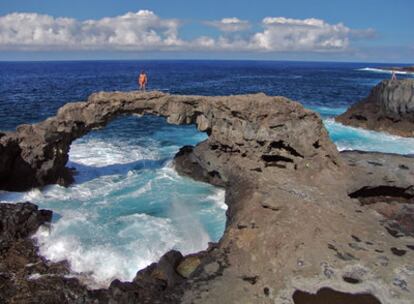Canaries for parched throats
The islands have unique traditions in winemaking and volcanic cuisine
Take the heavy meals associated with traditional Canary Islands cuisine, add a lunar landscape dotted with volcanic cones and the result is a state of complete relaxation that inevitably leads to a post-lunch nap. Visitors to the islands will be enthralled by the shadows made by clouds over the foothills of Timanfaya in a dance that borders on the hypnotic. Those mountains of fire still conserve enough heat to grill meat without a flame or matches.
Lanzarote, one of the oldest islands in the archipelago, took shape 18 million years ago, but the heat of its volcanoes can still be felt on the surface. The aptly named restaurant El Diablo, located in the heart of Timanfaya National Park, takes advantage of the geothermal heat rising out of the earth to prepare tasty grilled meat. Chicken, beef steaks and marinated meat skewers are cooked to perfection in a natural oven that is only 15 meters deep yet reaches temperatures of over 600ºC.
A large glass window covering the façade of the building affords panoramic views of the extensive lava fields. This breathtaking landscape located between the towns of Yaiza and Tinajo dates back to the volcanic eruptions that took place here over the course of six years, between 1730 and 1736. But don't choke on your meat - the last time any volcanic activity was recorded here was nearly 200 years ago. Still, it is interesting to watch a man pour a little water into a hole in the ground, and see it spat out seconds later by the geyser. Even a handful of dry grass will burn shortly after being placed inside one of these vents, where the temperature near the surface is around 200ºC.
Meanwhile, in the southern portion of La Palma, a cave dug into the volcanic rock houses an eatery called Bodegón Tamanca, featuring wooden tables, coal floors that crunch under each footstep and wine casks that hang over the tables. The latter are not just mere decoration: the owners use them to make their own wine. A few farming tools hang on the walls next to the traditional pichorras , the local name for dried pumpkins. The house specialty is also grilled meat, especially pork, with traditional side dishes like papas arrugadas con mojo picón (boiled potatoes with a layer of salt served with a spicy sauce).
It is a short drive from here to the active volcano of Cumbre Vieja, where the last eruption took place in 1971. Scientists watch the warm earth and when the wind blows in, the smell of sulfur is clear in the air. The Casa Museo del Vino, a wine museum in the same area of Las Manchas, displays farming tools and details about the way wine is made in La Palma, including the famous goloso malvasía that Shakespeare mentions in Henry IV.

Tu suscripción se está usando en otro dispositivo
¿Quieres añadir otro usuario a tu suscripción?
Si continúas leyendo en este dispositivo, no se podrá leer en el otro.
FlechaTu suscripción se está usando en otro dispositivo y solo puedes acceder a EL PAÍS desde un dispositivo a la vez.
Si quieres compartir tu cuenta, cambia tu suscripción a la modalidad Premium, así podrás añadir otro usuario. Cada uno accederá con su propia cuenta de email, lo que os permitirá personalizar vuestra experiencia en EL PAÍS.
En el caso de no saber quién está usando tu cuenta, te recomendamos cambiar tu contraseña aquí.
Si decides continuar compartiendo tu cuenta, este mensaje se mostrará en tu dispositivo y en el de la otra persona que está usando tu cuenta de forma indefinida, afectando a tu experiencia de lectura. Puedes consultar aquí los términos y condiciones de la suscripción digital.







































